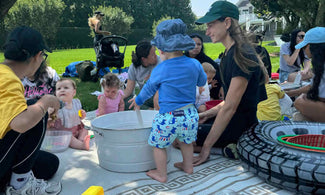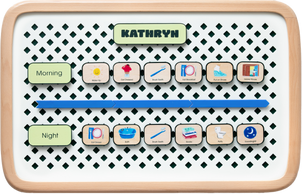Meet the Team: Jennie Monness
She’s the co-founder of Charmspring and Union Square Play.

You know that one friend who has the best parenting advice? That person at Charmspring HQ is Jennie Monness, she’s responsible for product innovation and storytelling and is the co-founder of Union Square Play, a parenting community and children’s play space for kids in New York City and beyond.
Jennie has been working with kids as an educator for over 15 years and empowering parents with tried-and-true strategies since becoming a mom to two daughters, Tess (6) and Nell (4). In this interview she shares why she loves working with kids and families and why she believes in Charmspring. Read on!
What led you to working with kids?
After studying for a Bachelor’s in Psychology during undergrad and a Master’s in Psychology and Education during graduate school at Teacher’s College at Columbia University, I applied to a daycare center through a Craigslist ad. It was in Chinatown and all of the kids spoke a different language than me. I had no idea what I was doing, but I knew I was in the right place.
Every day I loved finding ways to connect with them non-verbally, and I found that there were so many ways to build connections. It was so incredible to me that I could educate and build relationships with them through play and care. I learned that with kids our actions and energy matters just as much as our words, if not more.
How did your early experiences in the classroom lead you to Union Square Play?
During my time working in daycare, I got my teaching certifications, worked with kids of different ages through Pre-K, and eventually became a director of several programs. I also began my certification journey in the RIE® Educaring Approach, which helps adult caregivers see young children as competent and capable humans starting from birth.
Once I was expecting my first baby, I wanted to share everything I learned as an educator. I started sharing my knowledge on social media and Union Square Play was born out of a need for supporting new parents and building community in a physical space.
What excites you about Charmspring?
It’s so funny but one of my most popular social posts is a how-to for parents to create a visual schedule for kids using Shutterfly coasters and velcro. It was such a helpful, intuitive tool, and now we’ve created this company creating a product that both children and parents need, no DIY required!
Personally, I love how the company’s mission is to support families. Even though we make a child-oriented product, it’s meant to be used by parents and children together. The Springboard really helps create connection between kids and parents by giving them this built in time to connect and talk about the day and have easier transitions.
How does Charmspring fit into early childhood development?
It really helps with every stage. For babies, the tiles can encourage making early connections between abstract concepts and the real world (I.e. Having a tile that says “Wake up” with a sun illustration, and then showing the baby the actual sun shining outside their window when they wake up.)
For toddlers, it helps with early literacy skills since they notice the words on the tiles represent physical things and helps them conceptualize putting their routines in sequential order. With preschoolers, they can be empowered with agency. It’s even helpful for non-primary caregivers to connect with children through the Springboard since it outlines what’s happening every day.
What are common concerns, difficulties, or questions you hear from parents?
I get a lot of questions about how to ease children’s anxieties or challenges around separation, be it at school or anticipating a new experience. I actually think the Springboard helps because it establishes routines, leaves room for non-structured play time, and provides children with expectation setting.
Like if the kids are having a hard time getting to school, parents can use the Springboard to focus on the routine up until school: waking up, brushing teeth, eating breakfast, getting dressed, having a play session, and putting on their shoes.
This approach helps kids feel closer to each element of the experience instead of feeling like they are just being moved along, sometimes into unknown experiences. Transitions are tough for everyone, knowing what to expect can help make it feel better!
What’s some advice you’re often giving to parents?
I tell them to take on the perspective of the child and to think of them not as children but as people. It’s not always a reflexive mindset, but it helps us connect more productively with our kids.
For example, let’s say your kid can’t find their favorite pair of shoes for school and they are having an absolute meltdown. Instead of saying, “It doesn’t matter which shoes you wear!” I try to think about not being able to find my favorite jeans and how that would feel. I would say something like, “I know you really wanted to wear those shoes and we can't find them. It's so frustrating. We don't have time now, but we can maybe look for them after school. So what can we wear instead?”
It really helps to just acknowledge their feelings like you would to a friend. Putting ourselves in the position of our kids can help with literally everything.
What do you hope Charmspring brings to families' lives?
Our motto is, “Everyone’s a little bit braver when they know what’s coming next.” I would add to that and say, “Everything runs a little bit more smoothly when kids know what’s coming next.”
The Springboard won’t magically take away the challenges of raising kids (call me if you find something that does!), but it can make them easier and help families find more ways to create special moments of connection that bring levity to their everyday lives.
Did you enjoy getting to know Jennie? Meet Steph Korey Goodwin and Allie Klein, the rest of the team behind Charmspring!
